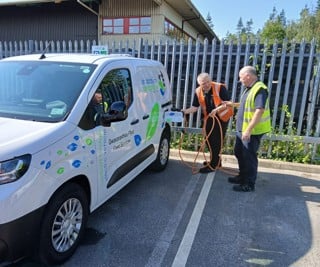Average CO2 emissions for cars across the FN50 have risen by a little more than 1g/km to 116.9g/km (up from 115.6g/km last year) and are now on a par with 2016 levels (117g/km).
Average CO2 emissions for cars delivered so far this year have risen further to 113.8g/km (up from 111.6g/km in 2017).
The trend is not surprising given the introduction of the Worldwide harmonised Light vehicle Test Procedure (WLTP) has seen average CO2 values (NEDC-correlated) rise across the board.
We might even have expected more than a 1g/km or 2g/km rise across the FN50 but, with vehicle availability problems and many fleet operators choosing to extend contracts this year, that increase may not be felt until next year.
Company car drivers have also been opting out of diesel vehicles and largely choosing petrol.
Diesel’s share of the FN50 is now at 63.4% (down from 71.4% last year) while petrol has risen to 29.4% (up from 22.4% last year).
This is further evidenced in the car orders placed this year with just over half (51.1%) being diesel and more than a third (36%) being petrol. For some fleet operators, this has undoubtedly had an impact on their average CO2 emissions.
“The fleet driver has access to hundreds of models and derivatives if they want an ICE (internal combustion engine) vehicle, but the choice of battery electric vehicles (BEVs) is very limited. This is unlikely to change before 2020." Matt Dale, ALD Automotive
However, countering that has been a rise in the uptake of electric (EV) and hybrid vehicles.
Last year, they had a 6.1% share (made up of 5.2% hybrid, and 0.9% electric), this year they make up 7.3% (2.5% hybrid, 3.2% plug-in hybrid and 1.6% full electric).
Full electric accounts for 3.4% of cars on order, with plug-in hybrid taking a 5.8% share and hybrid 3.8%.
Which leasing company leads the way in full-electric cars?
RCI Financial Services, which sits at number 16 in the FN50 and is the in-house finance company for both Renault and Nissan, has reported the highest number of full electric cars at 932, making up 6.8% of its risk car fleet of 13,692 vehicles.
Of the major leasing companies who responded to this year’s survey, Lex Autolease and Alphabet (GB) are leading the way.
The UK’s biggest leasing company has 795 full electric cars (representing 0.3% of its car risk fleet of 279,151 vehicles), 12,840 (4.6%) plug-in hybrids and 4,842 (1.7%) hybrids.
Its order bank this year has been 0.4% full electric, 7.3% plug-in hybrid and 2% hybrid.
Alphabet (GB), meanwhile, has 890 full electric cars (0.7% of its car risk fleet of 119,870), 9,911 (8.3%) plug-in hybrids and 1,862 (1.5%) hybrids.
Its order bank has been 0.5% full electric, 10.5% plug-in hybrid and 1.4% hybrid.
Alphabet believes there has been significant progress since it launched AlphaElectric – its four-stage process to help organisations transition their fleets to electric and hybrid, looking at fleet analysis, vehicle selection, charging solutions and mobility services – in 2013.
It believes there is now more public acceptance of EVs, more choice of EV models and more standardisation in terms of charging (although there still needs to be greater investment in the installation and maintenance of the public charging network).
Last year, it launched a mobility consulting tool (essentially in-vehicle data loggers) to help businesses identify which vehicles and journeys could be electrified but also where charging solutions need to be located.

Government 'short-sighted'
However, like many fleet industry professionals, Alphabet GB CEO Nick Brownrigg was hoping for clarity in the Budget over the benefit-in-kind (BIK) tax framework beyond April 2021 and for the Government to bring forward the BIK tax drop for EVs from April 2020 to April 2019 (FN50 went to press ahead of the Budget announcement).
The Government’s decision last month to reduce the amount of financial support available through the plug-in car grant (from £4,500 to £3,500 for the cleanest EVs and no longer available for hybrid cars with a range of less than 70 zero emission miles) has been widely criticised.
BVRLA chief executive Gerry Keaney believes it is “short-sighted” and will only serve to “stifle the uptake of EVs”.
Lex Autolease suggests that for the Government’s Road to Zero pledge of half of all new cars being ultra-low emission (ULEV) by 2030 to be achievable, there needs to almost a 23-fold increase in ULEV uptake, and incentives like the plug-in car grant are key to making it possible.
The Government currently defines a ULEV as a vehicle which emits 75g/km of CO2 or less, but this is expected to change to 50g/km or less from 2021.
£1m fund to drive EV adoption
Lex Autolease believes there is still a role for plug-in hybrids to play, particularly as there are still relatively few zero emission vehicles on the market.
It has launched a £1 million fund to drive EV adoption, with the first 1,000 customers to sign up for a pure EV from January 2019 benefiting from a £1,000 contribution. The leasing giant believes the move could increase the total number of pure EVs registered next year by around 8% and will help Lex Autolease to double the size of its pure electric vehicle fleet.
Arval, meanwhile, has launched an electric vehicle package which includes the leased vehicle, chargepoint installation and a charge card.
ALD Automotive’s Matt Dale believes that fleet managers should not rely on vehicle manufacturers and dealers for their charging solution as “they may have different offerings, which will not give a fleet manager a consistent supply or service to meet the fleet as a whole”.
However, he believes that a far greater challenge than charging infrastructure is the lack of product.
“The fleet driver has access to hundreds of models and derivatives if they want an ICE (internal combustion engine) vehicle, but the choice of battery electric vehicles (BEVs) is very limited,” he says.
“This is unlikely to change before 2020 with only a handful of new products coming to market during 2019 and the majority of those being premium product. Volumes of more mainstream offerings, such as Hyundai Kona, are likely to be limited through 2019, so this is not an easy challenge to overcome.
“The introduction of PHEVs is a good interim solution and more will be coming to market during 2019, meaning fleets can reduce their CO2 with some of these products.”
Jon Lawes, managing director of Hitachi Capital Vehicle Solutions, agrees: “With the current battery technology, EV range is only around 90 miles. However, with the increased kilowatt battery expected in vehicles in the next two-to-three years, it will be much more viable for fleets and consumers to move to EVs as range will increase to 250-plus miles.”
In the meantime, diesel still has a place on fleets and for high mileage company car drivers, it remains the best option.
It is no coincidence that Total Motion, number 24 in this year’s FN50, has the lowest average CO2 emissions (86g/km) of the FN50 and one of the highest proportions of diesel vehicles on its risk fleet (81.8%). It has also had the most diesel orders this year (80%).
Total Motion managing director Simon Hill says this is due to two factors.
“First, we built a modelling tool which allows clients to look at the impact of the fuel options before making a decision,” he says.
“Second, our clients tend to be higher mileage and still see diesel as being the right fuel for them.”



















Login to comment
Comments
No comments have been made yet.